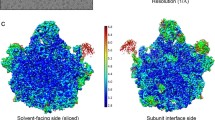Summary
Normal grown cells of Chlorella pyrenoidosa incorporate uridine exclusively into chloroplast ribosomal RNA after short time labeling. With sucrose gradient separation, labeled ribosomal particles of 70 S, 50 S and 30 S can be shown. This labeling is prevented by rifampin in low concentrations after a few minutes. At the same concentration of the antibiotic and also with 10-fold higher concentration, no effect on heterotrophic cell growth is observed. This indicates clearly that mitochondria cannot be influenced by rifampin. Chloramphenicol also inhibits the formation of uridine labeled ribosomal particles of 70 S, 50 S and 30 S. In the presence of this antibiotic, some labeled ribosomal RNA is formed. Also the effect of chloramphenicol can be shown after short incubation periods. Cycloheximide treatment of the cells within 30 and 60 min and up to the 10-fold concentration of protein synthesis inhibition (Morris, 1967) results in no effect on labeling of ribosomal RNA and of ribosomal particles in Chlorella with uridine. Only after prolonged treatment of the cells with cycloheximide is some effect on uridine incorporation observed.
The comparison of the incorporation patterns of 6-(14C)-orotate, (6-14C)-uridine and 5-(3H)-uridine into nucleic acids in the presence of rifampin, chloramphenicol and cycloheximide shows some similarities. After 60 min incubation with the precursors, the incorporation is reduced by all three antibiotics. In rifampin treated cells, orotate and both uridines are preferentially incorporated into DNA. With chloramphenicol, the relative incorporation of orotate and of uridine into the 5 S and the 16 S RNA is higher as compared with the 23 S RNA. Cycloheximide results in an increase in the relative incorporation of orotate as well of uridine into DNA. The similarities of the effects of the three antibotics indicate that the preferential incorporation of uridine into chloroplast ribosomes of Chlorella is not due to a compartmentation of the uridine-UMP-pathway.
Zusammenfassung
Chlorella pyrenoidosa inkorporiert unter normalen Anzuchtbedingungen kurzfristig angebotenes Uridin fast ausschließlich in plastidäre ribosomale RNA. Es lassen sich rasch markierte Ribosomen und deren Untereinheiten von 70 S, 50 S und 30 S nachweisen. Diese Markierung wird durch Rifampin in geringen Konzentrationen bereits nach wenigen Minuten unterbunden. Auf das Zellwachstum hat Rifampin bei heterotropher Anzucht dagegen auch in höheren Konzentrationen keinen Einfluß. Chloramphenicol hemmt den kurzfristigen Uridin-Einbau in ribosomale Partikeln von 70 S, 50 S und 30 S, nur geringfügig dagegen denjenigen in ribosomale RNA. Auch die Wirkung des Chloramphenicols tritt rasch ein. Cycloheximid beeinflußt den Kurzzeit-Einbau von Uridin in ribosomale Partikeln und in RNA nicht, wenn die Inkubationszeit 60 min nicht überschreitet.
Die Markierung der Nucleinsäuren von Chlorella mit 6-(14C)-Orotsäure zeigt vergleichbare Empfindlichkeiten gegen die drei Antibiotica wie der Einbau von 6-(14C)-Uridin und 5-(3H)-Uridin.
Similar content being viewed by others
Abbreviations
- BisMSB:
-
bis(O-Methylstyryl)-Benzol
- PPO:
-
2,5-Diphenyloxazol
- MAK-Säule:
-
Säule aus methyliertem Albumin mit Kieselgur
Literatur
Brändle, E., Zetsche, K.: Die Wirkung von Rifampicin auf die RNA-und Proteinsynthese sowie die Morphogenese und den Chlorophyllgehalt kernhaltiger und kernloser Acetabularia-Zellen. Planta (Berl.) 99, 46–55 (1971).
Ebringer, L.: The action of nalidixic acid on Euglena plastids. J. gen. Microbiol. 61, 141–144 (1970).
Galling, G.: Analyse des Magnesium-Mangels bei synchronisierten Chlorellen. Arch. Mikrobiol. 46, 150–184 (1963).
Galling, G.: Ribosomes in unicellular green algae I. On the cytoplasmic monosomes of Chlorella. Cytobiol. 1, 304–315 (1970).
—: Der Einfluß von Rifampicin, Chloramphenicol und Cycloheximid auf den Uridin-Einbau in chloroplastidäre Ribosomenvorstufen von Chlorella. Planta (Berl.) 98, 50–62 (1971).
—, Ssymank, V.: Bevorzugter Einbau markierten Uridins in die Vorläufer von Chloroplasten-Ribosomen in Algenzellen. Planta (Berl.) 94, 203–212 (1970).
Ingle, J.: The effect of light and inhibitors on chloroplast and cytoplasmic RNA synthesis. Plant Physiol. 43, 1850–1854 (1968).
Kuhl, A.: Zur Physiologie der Speicherung kondensierter anorganischer Phosphate in Chlorella. Beitr. z. Physiologie u. Morphologie der Algen, S. 157–166. Stuttgart: G. Fischer 1962.
Leoning, U. E.: The determination of the molecular weight of ribonucleic acid by polyacrylamide-gel-electrophoresis. Biochem. J. 113, 131–138 (1969)
Morris, I.: The effect of cycloheximide (actidione) on protein and nucleic acid synthesis by Chlorella. J. exp. Bot. 18, 54–64 (1967).
Richter, G., Senger, H.: Extraktion und chromatographische Auftrennung der Nucleinsäuren aus Photosyntheseorganismen. Biochim. biophys. Acta (Amst.) 87, 502–505 (1964).
Smillie, R. M., Graham, D., Dwyer, M. R., Grieve, A., Tobin, N. F.: Evidence for the synthesis in vivo of protein of the calvin cycle and of the photosynthetic electron-transfer pathway on chloroplast ribosomes. Biochem. biophys. Res. Commun. 28, 604–608 (1967).
Ssymank, V.: Einfluß des Stickstoffmangels auf den Nucleinsäurestoffwechsel und die Ribosomen-Synthese bei Chlorella. Diss., Göttingen 1971.
Surzycki, S. J.: Genetic functions of the chloroplast of Chlamydomonas reinhardii: Effect of rifampin on chloroplast-dependent RNA-polymerase. Proc. nat. Acad. Sci. (Wash.) 63, 1327–1334 (1969).
Tewari, K. K., Wildman, S. G.: Function of chloroplast DNA, I. Hybridization studies involving nuclear and chloroplast DNA with RNA from cytoplasmic (80 S) and chloroplast (70 S) ribosomes. Proc. nat. Acad. Sci. (Wash.) 59, 569–576 (1968).
Wanka, F., Poels, C. L. M.: On the problem of enzymatic regulation of DNA synthesis in Chlorella. Europ. J. Biochem. 9, 478–482 (1969).
Wintersberger, E.: Die Bedeutung der Mitochondrien-DNA für die Organellen-Biogenese. Ber. dtsch. bot. Ges. 83, 353–357 (1970).
Author information
Authors and Affiliations
Rights and permissions
About this article
Cite this article
Galling, G. Einbau von Uridin und Orotsäure in plastidäre ribosomale RNA von Chlorella nach Antibiotica-Behandlung. Archiv. Mikrobiol. 81, 245–259 (1972). https://doi.org/10.1007/BF00412243
Received:
Issue Date:
DOI: https://doi.org/10.1007/BF00412243




